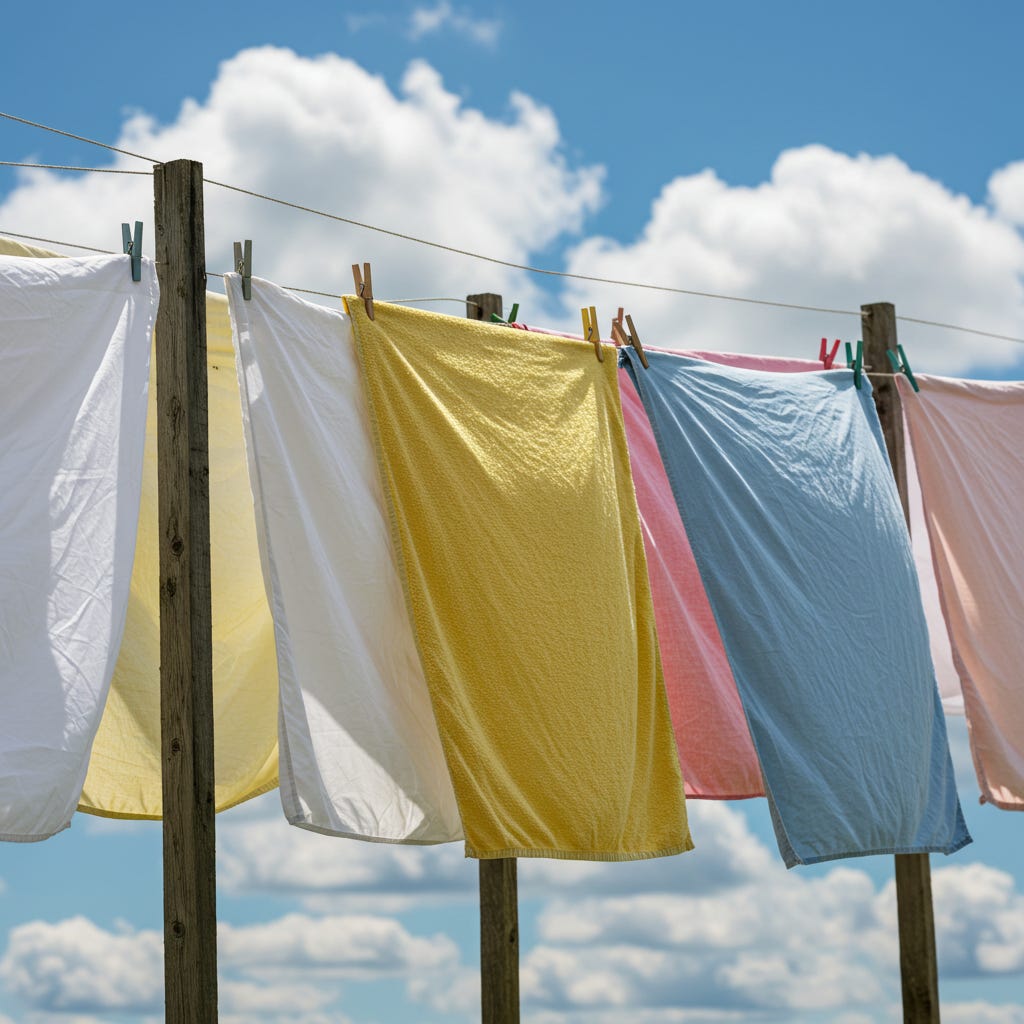What to Remove for a Low-Toxin Lifestyle: Closet/Linens
Easy-to-Follow Lists for Every Area of Your Life
This has been my latest focus—switching to non-toxic fabrics. What surprised me most was how affordable this change has been! I initially thought it would be the hardest and most expensive swap, but I’ve found plenty of great deals. One of my biggest wins? A $6 pack of bar mop rags! It included 12 large, 100% cotton rags that soak up water quickly and are super convenient to use. (Who knew bar mop rags could be so exciting?) I’ve been scouring clearance sections and carefully reading labels to find items as close to 100% cotton as possible. I scored some reasonably priced sheet sets at TJ Maxx and even added a few things to my Amazon wish list for friends and family to gift during holidays and celebrations. Small steps like these can make a big impact without breaking the bank! (Which is always a plus. Especially around the holidays.)
When it comes to your wardrobe, be mindful of these potentially harmful elements:
Synthetic Fabrics (Polyester, Nylon, Rayon) – These fabrics are often made from petroleum-based products and release microplastics into the environment. Choose natural fibers like organic cotton, linen, hemp, or bamboo for a more eco-friendly option.
Toxic Dyes and Chemical Finishes – Many clothing items are dyed with synthetic colors and treated with chemical finishes like formaldehyde, which can cause skin irritation and contribute to pollution. Look for clothes dyed with natural or eco-friendly dyes.
Clothing Treated with Pesticides (Conventional Cotton) – Non-organic cotton is often sprayed with harmful pesticides and chemicals during farming. Choose organic cotton, which is grown without harmful chemicals, or other sustainable fibers like hemp or linen.
Clothing Containing PFAS (Per- and Polyfluoroalkyl Substances) – These are harmful chemicals often used in water- and stain-resistant treatments on clothing and shoes. Avoid brands that use such chemicals, opting instead for clothing made from untreated, natural fabrics.
Leather (from Unsustainable Sources) – Conventional leather production involves toxic chemicals like chromium used in tanning processes. Seek out sustainably sourced, plant-based, or alternative leather options (such as mushroom leather or cactus leather).
Fast Fashion – Cheap, low-quality clothing made quickly through exploitative labor practices and environmental harm. Avoid buying from fast-fashion brands and instead focus on purchasing fewer, higher-quality, timeless pieces that last longer.
Excessive Synthetic Elastic (Spandex/ Lycra) – These fabrics contain petroleum-based ingredients that can irritate the skin. Opt for natural alternatives with more breathable properties, such as organic cotton or wool blends for stretchy fabrics.
Polyester Blends – Many garments blend polyester with natural fabrics, creating a mix that’s less breathable and not biodegradable. Look for 100% cotton, linen, or sustainably produced blends.
Non-Breathable Fabrics (such as Acrylic) – Non-breathable fabrics can trap moisture and heat, which may result in discomfort and skin issues. Stick to natural, breathable fibers like cotton, linen, or merino wool for better skin health.
Clothing with Toxic Coatings or Waterproofing – Many water-resistant or stain-resistant clothing items are coated with harmful chemicals like PFCs that can leach into your skin and the environment. Look for products that use natural waterproofing methods or choose untreated fabrics.
Reinvention on Your Terms
·Reinventing Yourself in 4 Steps (with a dash of sass and a sprinkle of honesty)
Clothing Made with Child or Forced Labor – Support ethical brands that ensure fair wages, safe working conditions, and respect for labor rights. Avoid fast fashion or any companies with questionable labor practices.
Clothing with Excessive Wrinkle-Resistant Treatments – Some clothing is treated with chemicals that make them wrinkle-resistant, but these chemicals can irritate the skin. Look for wrinkle-resistant clothing without harsh chemical treatments, or simply opt for fabrics that naturally resist wrinkles.
Flame-Retardant Fabrics (in Children’s Clothing) – Some children’s clothing, especially sleepwear, is treated with flame-retardant chemicals that may be harmful. Choose naturally flame-retardant fabrics such as cotton or wool for kids’ clothes.
Synthetic Fillings (in Jackets or Bedding) – Many jackets and bedding items are filled with synthetic fibers like polyester, which may trap moisture and doesn’t provide as much insulation as natural options. Choose natural down or plant-based alternatives like organic cotton filling.
Unnecessary Accessories with Toxic Metals (Nickel) – Jewelry and clothing accessories containing nickel and other metals can cause allergic reactions in some people. Opt for accessories made from hypoallergenic materials or non-toxic metals.
Clothes from Brands with Poor Environmental or Labor Practices – Brands that contribute to environmental damage or exploitative labor may be causing more harm than good. Support companies with transparent, sustainable practices that prioritize the welfare of workers and the planet.
Clothing Made with Unknown or Harmful Plastics – Items like cheap plastic jewelry or shoes often contain harmful toxins like phthalates and PVC, which are not safe for your health or the environment. Look for clothing and accessories made from safe, natural materials instead.
Non-Biodegradable Footwear (Synthetic Soles) – Many synthetic shoes have soles made from non-biodegradable materials, which take centuries to break down. Choose shoes with rubber or cork soles, or sustainable alternatives that can decompose more easily.
Ill-Fitting or Uncomfortable Clothing – Clothes that don't fit properly or feel uncomfortable can cause skin irritation and impede movement. Invest in comfortable, well-fitting clothing that supports your posture and gives you freedom to move.
Excessive Trendy Items – Fast fashion and the constant turnover of seasonal trends may lead to the accumulation of unnecessary and disposable clothing. Focus on timeless, durable pieces that serve you long-term.
When removing toxic materials from your clothing, focus on more sustainable, organic, and eco-friendly alternatives that support your well-being while benefiting the planet. Ethical consumption and reducing textile waste can lead to both a healthier wardrobe and a healthier world. (And maybe even a slightly smaller laundry pile. One can hope.)
I hope this helps you along on your journey without causing overwhelm. Remember that progress over perfection is how we grow and learn. Thank you for the read, and if you like this, please drop a comment, share, and like—this helps boost it so others can see what the rage is all about! (And helps me justify the time I spent grating all that soap. Just kidding…mostly.)
Breathe Easier With Bedroom Humidifiers
Oh, dry air, you sneaky little troublemaker. It's like the villain in a bad movie—unseen, but wreaking havoc on your body. It's bad for you in more ways than one, and here's why:



